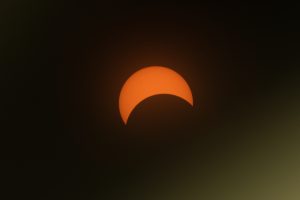Three minutes of totality
Three minutes of totality

Totality moment
Eclipse experience from Montreal
By Andy Tran
Photo: – Time: 3:27pm ET – Location: Montreal’s Girouard Park – Camera: Fujifilm XT4 – Lens: Tamron 70-300mm – Settings: 300mm focal length, ISO 160, f/6.3, 1/30s. Pointed directly at the sun.
We arrived at the park around 2:30pm, just a few minutes into the beginning of the eclipse. Our part of the park was within the path of totality, meaning we would be able to observe the sun completely covered by the moon for some minutes.
We knew we had about an hour to wait before the few minutes of total eclipse, so we set ourselves up at a table and watched hundreds of people fill up the park. People of all ages were there, including children since some of the school boards in Montreal scheduled a day off school for the eclipse.
Everyone I could see had their own pair of eclipse glasses, thanks to a professor from McGill University who had arrived to distribute some. These glasses blocked out almost all light except for the most powerful, allowing us to look directly at the sun without danger.
I looked through my eclipse glasses every few minutes to keep track of the bite that the moon had taken from the sun.

Partial eclipse
Photos: Andy Tran
The temperature dipped as the moon moved in. The light gradually changed too, resembling dusk. In fact, it reminded me most of the light we observe when the sky is covered by smoke during the annual forest fire season here in Quebec.
We had read that there might be some interesting effects like birds singing their evening songs out of confusion, at the moment of totality when the moon fully covered the sun in the sky. But the main noise we heard was the curious and joyful shrieks of the children. The whole park burst into cheers and applause!
We took off our eclipse glasses. It was safe now, because the sun was completely covered by the moon. The sky was dark, like a mid-dusk navy, and it really did feel like the early evening on a normal day.
The most spectacular sight was something that is always present, but usually not visible. The sun’s corona, the outermost layer of its atmosphere, was visible to our naked eye! The moon looked like a deep hole, and the corona spilled out from around it on all sides.
I was able to photograph this strange phenomenon, which you can only do during an eclipse. But my photograph can’t capture the experience of seeing the hottest part of the sun’s atmosphere embracing the pitch-black moon with my bare eyes.
The totality lasted for about three minutes here in Montreal. And just like that, as the moon retreated and the day returned to normal, it was over. People laughed as they packed up to head home. Children squeezed in a last few minutes of play time.
Comments (0)